Updates
Waste Management at Battens Lane
Even small DIY jobs seem to end up with loads of rubbish, and my family will tell you how much of a pain I can be about sorting rubbish for recycling. So on site I’ve put a lot of thought into it and am finally getting the system working properly.
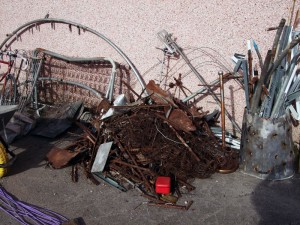
Separated scrap materials.
Scrap metal was easy to dispose of. To deal with the rest I found a skip company with a good system for separating waste so that when we did need to send mixed and construction waste it would be properly processed.
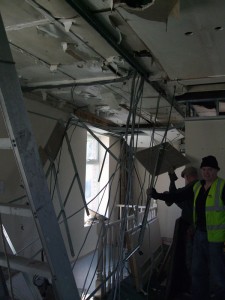
Wires being recovered.
When it came to stripping out the building, we re-used the kitchen in the welfare/break room along with some of the lights, and cleaned up most of the timber to re-use. A lot of wire came out which has been checked and some of it used in the lock-ups, with more available when we do more on them later in the project.
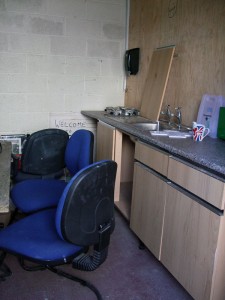
Re-using the kitchen.
There was also a lot of plasterboard to remove, and that has to be separated by law and went with our skip provider. We also took the frame from the suspended ceiling along with the other scrap metal and saved a bit of money.
We have a lot of stone and old bricks which came out when the new door and window openings were made. Some of the stone has been traded with our blockwork subcontractors, Archway, toward some walling work we need later on, and our volunteers have been working hard cleaning up the whole bricks to make them usable for raised beds or perhaps for paving the yard. Most recently the double glazed units from the old windows were advertised via Gumtree and collected by a family using them to build a greenhouse at their allotment.
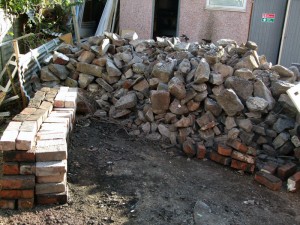
Reclaimed stone and bricks.
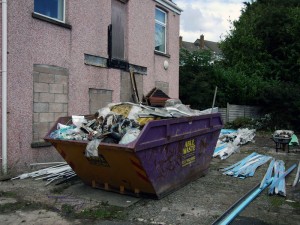
Waste cleared and sorted.
So with enough attention to detail we can dispose of a huge range of stuff usefully. One unsolved problem, though, is the sawdust from the workshop. It is mostly treated timber so can’t be used for animals or compost and I’d rather not just dump it in the skip. I’m hoping one of the local companies which handles scrap wood will let us have a dedicated bin to collect it for them.
It all goes to show that as well as reinventing a building we can re-use a great deal of what comes out of it.
Meeting the Architects
Behind every successful dwelling is an architect – even if the building is converted from an existing one. Our project at Battens Lane is in the hands of Chris Askew and his colleagues, who run a practice in Bristol that specialises in sustainable, community oriented projects.
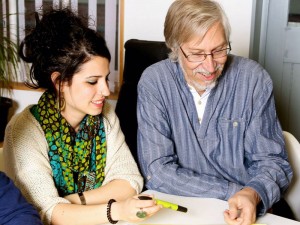
Chris and Nerea in the studio
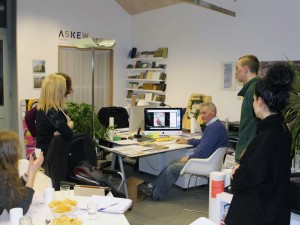
Meeting of prospective residents at
Askew Cavanna studio, looking at finishes
And, crucially, it was mortgageable. That eventually allowed AEOB to secure the loan from Triodos bank that led to the start of building last year. “A twenty-year mortgage is perfectly supportable for us. This is a long-term project, and the figures work.”
With planning and finance in place, the construction has now begun, guided by the detailed plans for, in effect, two buildings – one the conversion of the old structure, one the new, timber-framed extension which will add two flats to the completed complex. The two parts will offer a model of how to refashion an old structure to modern standards, and how to think about organising several dwellings in a single development.
The project architect, Nerea Gonzalez, qualified in Spain, in Pamplona, and came to Bristol to be involved in just such new ways of doing things. After two and a half years, she says, “I feel Bristol still has a lot to teach me about community and social issues. We need this kind of energy and ideas in Spain.”, she says.
Together, she and Askew have worked on details that maximise the benefits of the building and the site. Conforming to the existing plan means the flats are relatively small, so there is much to be gained from space-saving in the detailed design. High-performance, hence low-volume, insulation, under floor heating that obviated the need for radiators, and a common laundry room will all help here. Happily, these options are also in line with other important aims, including low-impact, sustainable construction, and low running costs for the tenants.
Anyone designing buildings for people to live in is looking for a long-lasting result. “People come and go, but the building will stay”, says Askew. At the same time, the prospective tenants who have already come forward are involved in as many design decisions as possible. The day we meet, there is an evening session scheduled where the tenants’ group will inspect samples of floor and wall finishes for all the different rooms – there are a range of tiles and floor coverings fixed to a board to focus the discussion.
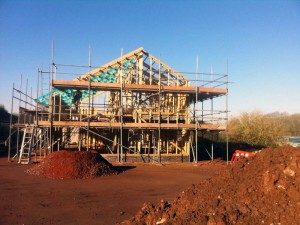
Solarsense Renewable Energy Demonstration Centre –
Being built by Natural Design and Build,
who will be doing the timber frame at Battens Lane
That will mark real progress on the extension. The detail of the larger, old building will be different. “It’s like an old pair of jeans, that’s been patched up over the years”, says Askew. But so far there have been no expensive surprises as the old structure had been stripped out and prepared for the next phase of its life.
“The first place you tend to lose money is underground”, says Askew. With the old structure stripped back, the foundations in place for the extension, and the drains dug, the contractors haven’t uncovered any subterranean problems. Although there is contingency in the budget, things look well advanced to Askew’s experienced eye. It’s a complicated building, but we’re now in a position to tighten up on the cost plan”, he says, which is good news with £100,000 of investment still needed to meet the full development cost before completion in the Autumn.
The whole project exemplifies a feature of architectural practice that must be particularly satisfying. If you really care about things that matter for the future – like affordable housing, using natural materials, energy efficiency and sustainable living, you can actually build things that embody those principles from the foundations to (solar panelled) top.
Work on Site is Moving Ahead Swiftly
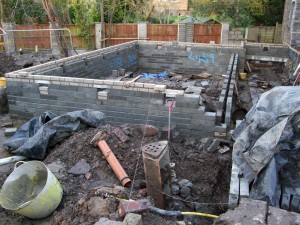
Rising up: Block walls begin to take shape
There was a query about where joists for the new extension would sit which we couldn’t resolve from the plans, so Archway got on with the drains while the architects and structural engineers double-checked everything and clarified exactly what goes where.
This week work on the drains continues, and digging out has now exposed the incoming gas, electric and (shortly) water supplies. We know where they go but will have to put up with them being in the way until the timber skeleton for the new building is there for us to move the main supply anchor points.
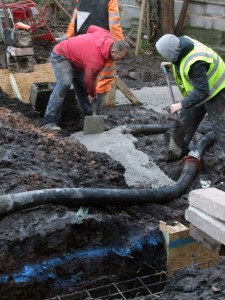
Sound foundations: Pouring concrete
before Christmas
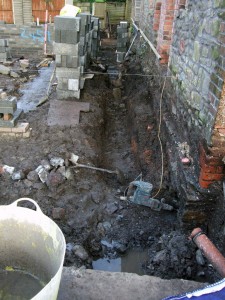
Digging in: A trench for the drains
Away from the site, Site Manager Elinor has tracked down the owner of the building before last occupants, Database, who still operate out of workshops in Kingswood. When they bought the property (From Fussell & Watts, whose details we had found on packing cases) they were given a pack of old deeds, charges, letters and documents dating some as far back as 1920s. These will give an even better picture of the history of the building, and maybe enough clues to look back even further. The rumour we had heard that the buildings were once stables appears to be correct. She is going to contact the local history society to see if anyone knows more or has pictures.
Battens Lane – end of year report
What’s going on at Battens Lane? Shareholder Jon Turney went down to St. George to see.
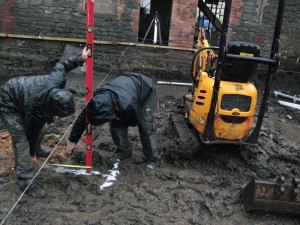
Precision measuring, meet south Bristol clay –
Marking the trenches for the new foundations.
And now we have them! The screw piles we chose were carefully inserted over the last week – they don’t need to sit as deep down as conventional piles, which suits the stiff clay underlying the site and cuts the amount of concrete needed, too. The next stage is to lay the concrete, which will then cure over the Christmas break. That means all is ready to begin building the timber frame for the extension in the new year.
It’s been a foundational year for AEOB in more ways than one. That setting concrete shows how far we’ve come, and confirms the project is on course for tenants to move in next autumn. But that in turn depends on the work achieved in 2015 to move AEOB on financially, legally, architecturally, and in our dealings with the planning system, as well as recruiting site workers and signing up the contractors who you can now see on the front page of the website. There’s the small matter of another £100,00 investment still needed to bridge the gap between what we can draw on from our existing investments and our Triodos mortgage and the projected total cost – but that will need more work next year.
I knew the site was developing fast, but that has kept everyone so busy – in a good way – that regular bulletins on the work in progress have been hard to maintain. So I went down there to see for myself. Here’s what’s going on, by way of an overall update, and as a prelude, I hope, to more frequent reports in 2016.
Elinor Kershaw, now well installed as project and site manager, says happily that the work “is all going reassuringly smoothly: we’re absolutely bang on schedule at the moment”. The day I showed up, extra scaffolding was in evidence, as a prelude to installing additional solar panels on the Southern slope of the roof. Extra lintels to support the panels were already in place. A small digger on the other side of the building indicated where the pile driving was following the outline of the extension.
So there was work in progress at the top and bottom of the building. In between, the shell of the old building (What was it originally? That’s uncertain but it was definitely a plastic film extrusion outfit not that long ago) has been reworked so you can see how the flats inside will take shape.
The old floors and the interior have been stripped out (the pine flooring will be re-used for some of the flats) and door and window openings remodelled. The North facing side of the building was originally stone, contrasting with the unusual triple layers of brick on the other three faces – again we’re not sure why – and is now a pleasing patchwork of old stone and brick. Plans for installing the under floor heating are well advanced, which along with the solar panels will help ensure the flats are cheap to run.
The new year will see a further schedule of new construction, with work starting on the timber frame on Feb 1, on a contract agreed with Natural Design and Build in early December. Then there’s lots more detailed work on the whole building. Drainage on the extended site still needs attention. The under floor pipes will be laid. There are stones and bricks to sort. The outbuildings, one now in use as a well-equipped carpentry workshop, will be remodelled as well. And there are plenty of possibilities to review on energy management, including whether suitable batteries can be installed to make best use of the solar panels, and even whether the currently planned boilers will ultimately be needed.
If that’s not enough, the work to develop the bigger picture that AEOB could be a part of needs to continue in tandem. Visitors come to see how the project was set up – the latest from a Community Land Trust in Lewisham in South London. And Bristol Green Capital promise to help arrange some financial modelling that should help make the case for larger-scale efforts to make better use of empty buildings that could be turned into homes.
The team continue to document how the project has got this far, so what has been learnt can be passed on to people in other cities. Lots of things about the project are locally specific. But Elinor sees lots to pass on from the processes and ways of working that have emerged in Bristol, and from experience here of the kinds of people and organisations to work with the move a project like this from a gleam in the eye to a real effort of brick, stone and concrete. As a (modest) investor, it’s great to see at first hand, and it will be even more exciting to see Battens lane take shape as a dwelling in 2016. Now we need to turn that excitement – and the project deadline – into a boost for raising the remaining capital in the new year, and ensuring the work that has gone so successfully up to now reaches completion on schedule.
Contractors start work on AEOB Battens Lane Affordable Housing
Exciting times on the project – our Community work force have done a great job over the last months, stripped the building and set out the building dimensions with a second hand theodolite off eBay (part of ‘upskilling’ our workforce). They also set up the welfare and storage facilities making use of the old garages on site, all with materials recycled out of the old building. Contractors were selected by a tendering process run by our small team.
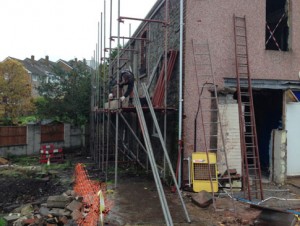
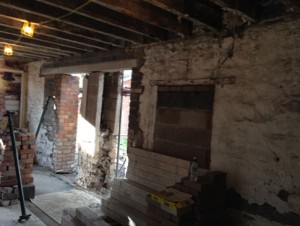
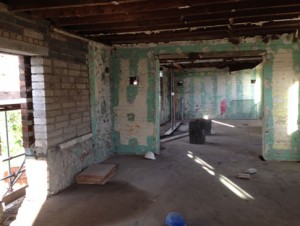
Contractors installed scaffolding on 6th November, and Archway Construction have already made new window and door openings in the thick stone and old brick walls. In the picture, you can see that we re-finished some of the walls with bricks taken from the demolition. These areas will be visible in the final building intentionally showing some of its history.
Our share offer is still open and we need your investment to continue this good work!
Bristol housing charity closes £425,000 in funding
Today AEOB achieved financial closure of the Triodos Bank facility. This landmark enables us to proceed with placing contracts for the major build work and get on track to turn this building over to tenants in a year. Our potential residents are delighted that we have now a live project with an end date, and affordable, low energy accommodation at the end of it.
AEOB (AEOB House People Ltd) is a Community Benefit Society granted charitable status by HMRC and is a non-profit organisation.
BBC – Bristol campaign group starts works…
We’re on the BBC website again. Hopefully we were/will be on Points West this week.
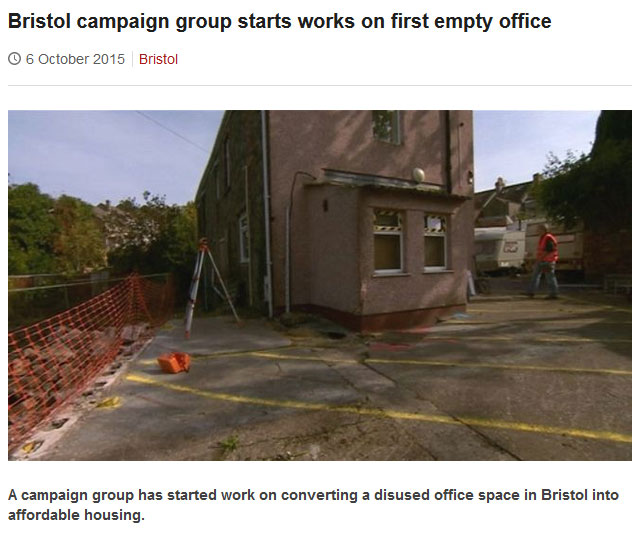
The campaign group raised nearly £300,000 through a Community Share Offer to buy the former business in St George
Follow Link to Article:
https://www.bbc.co.uk/news/uk-england-bristol-34451690
Bristol charity prepares first empty office for refurbishment
Having secured financing from Triodos Bank and engaged Solicitors to complete the transaction, we kicked off work on site with volunteer labour to empty the old offices of its contents.
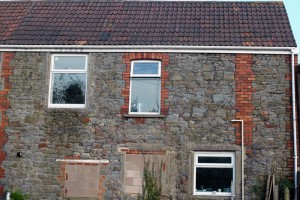
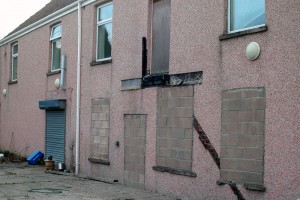
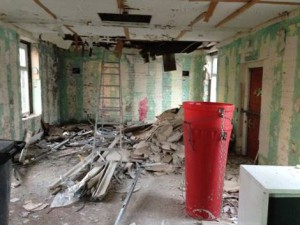
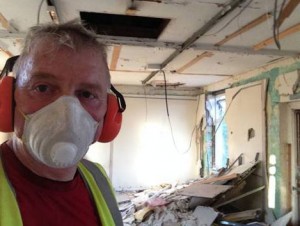
Many of the items left we were able to sell on EBay to help fund the charity, raising about £400 in the process.
Volunteers cleared the garden and set up the garages so that we could use them as a welfare and site facility.
We then stripped out the interior starting with the plumbing, radiators, electrical systems and mile upon mile of communications cable. Anything that we could re-use or recycle we have done. The garages now have electrical power and light with fittings from the old building, and we used the old kitchen units as well.
At the same time we were having meetings with architects and potential contractors and developed a project plan.
Now the building site for the timber frame extension has been surveyed by our own people and set out with the building profiles, ready for foundation excavation.
AEOB (AEOB House People Ltd) is a Community Benefit Society granted charitable status by HMRC and is a non-profit organisation.
AEOB secures finance for first building conversion
Social investment turns empty commercial premises into affordable housing in Bristol
Abolish Empty Office Buildings (AEOB) will start to convert its first property to affordable housing in Bristol next month (September). The Community Benefit Society has now secured finance to commence the build.
Our pioneering scheme will see the first tenants move in to secure rented accommodation before the end of 2016, with works expected to take 12-15 months.
AEOB has raised nearly £300,000 from a Community Share Offer, which allowed acquisition of our first property in St George in East Bristol. Triodos Bank have now granted a £425,000 mortgage, giving the green light for full building work to begin. The redundant workspace will be completely refitted and extended, creating six flats which will house up to 10 people.
The share offer remains open, to fund the balance of the work, and to expedite repayment of the loan. Triodos’ finance ensures completion of this project, which is intended as a demonstration of what can be achieved with empty properties. We hope it will be the first of many.
AEOB is addressing the UK’s housing crisis by buying unused commercial premises and converting them into affordable rental units with secure tenancies. Each development will be owned by AEOB but managed by a tenants’ co-operative.
We are now gathering a group of prospective tenants in Bristol who will:
- be diverse but share a commitment to living co-operatively
- be involved in shaping the project
- contribute to further AEOB housing projects by sharing experiences and skills
Much of the money raised to date from our Community Share Offer came from investors in Bristol, but there have also been contributions from as far away as Scotland. AEOB founder Tony Crofts said: “We have clearly struck a chord with those who “have” and want to make an ethical investment to support those who “have not”. We are delighted to be working with Triodos UK to move this first project onward to completion”. John Cook, one of the first prospective tenants, said: “It’s nice someone’s not in it for the money”.
AEOB hope to inspire others to create similar projects, and will franchise their model to other groups and other cities, who are encouraged to get in touch.
May update
Our main effort continues to be our funding campaign. Now we have a building to develop, we need to get the remaining capital in place for the conversion as soon as possible. Our title to the property will secure a loan, and the steering group are working hard on the Business Plan, preparing to contact ethical lenders. We still need further private investment to strengthen our position when we make formal application for a loan. It is likely we will seek to match the money we have, so our current aim is to raise fifty per cent of the likely total project cost ourselves.
In that connection, we will be attending the Triodos annual meeting in Bristol on June 20, so look out for the AEOB people working the room if you’re there and come and have a chat. There’ll be copies of our new leaflet in delegates’ bags, too.
On site, we continue to firm up the details of the work that will be needed. The architects have been up in the roof taking measurements of the timbers which need to stay and working out how they affect the extension. Our site manager Elinor has also had a chance to look at the more detailed plans which are coming together, as well as at how the new and old parts of the building will work together, and is starting to think about the order of works with a view to weather-tightness during the build.
We are also looking into who might lead on the timber frame, and have contact with some people who have experience working with community workforces.
The group of prospective residents is meeting monthly and developing a core of interested people. We are starting to look into the skills available and how other skills can be developed. There’s still space for more people so we welcome contact from anyone interested in living at or working on the site.